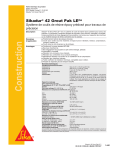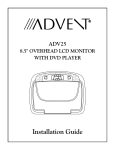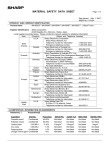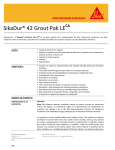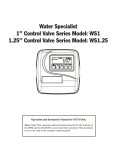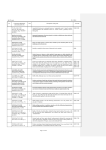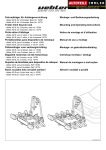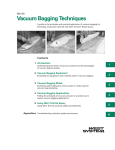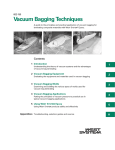Download Product Guide - PRO
Transcript
August 2015 The New Standard Rossion Q1 by Rossion Automotive, Riviera Beach, FL PRO-SET EPOXIES for Laminating, Infusion, Tooling and Assembly | ISO9001:2008 Certified prosetepoxy.com | 888-377-6738 | Gougeon Brothers, Inc., P. O. Box 908, Bay City, MI 48707 | Contents Laminating epoxies 2 Infusion Epoxies 4 ADHESIVE EPOXIES 6 Tooling EPOXIES 8 Surfboard EPOXIES 10 PROCESS EQUIPMENT 12 Metering Equipment Adhesive Dispensing Guns Impregnators Quality Control Dye PERSONAL PROTECTIVE Clothing SUPPLEMENTAL INFORMATION 15 Shelf Life AND STORAGE Standard Package Sizes PRO-SET EPOXY HANDLING GUIDE 16 Safety Handling PRO-SET Epoxies Application Techniques Post-CUring Quality Assurance Considerations Pro-set Epoxy Testing Terminology and Methods GARC built by Hodgdon Defense Composites. Preparation of Test Specimens Handling Properties Mechanical Properties Thermal Properties 27 Use PRO-SET Epoxy to create strong, lightweight composites that can withstand the harshest environments. PRO-SET meets your highest goals in composite performance. We’ve reformulated and expanded our standard PRO-SET epoxy product offerings to best meet the needs of modern, high-performance composite manufacturing. Standard PRO-SET Epoxies for Laminating, Infusion, Tooling and Assembly offer improved handling characteristics, excellent cure profiles, and rapid order fulfillment at competitive prices. This guide provides an overview of the PRO-SET product lineup with a comparison of resin and hardener handling characteristics and cured properties, and a general PRO-SET Epoxy Handling Guide. Refer to the individual combined Resin/Hardener Technical Data Sheets for detailed handling, ratio, mechanical and thermal property information. Custom Formulation PRO-SET can formulate custom resin and hardener systems tailored to your specific processes and performance needs, working closely with you throughout the development of your custom formulation. Turnaround times are generally rapid, with only slightly extended lead times required once your custom formulation is placed into production. PRO-SET custom formulations usually require minimum volumes, and these products are typically made available under our Custom Formulations category, unless the customer specifies them as proprietary. Fire Retardant resin for laminating and infusion is now available as Special Order Formulations. Contact the Gougeon Technical Staff or visit prosetepoxy.com for details. PRO-SET User Manual & Product Guide 1 Laminating epoxies Vacuum lamination in progress PRO-SET Laminating Epoxies are a versatile system of liquid resins and hardeners designed to meet a wide range of wet lay-up laminating applications. LAM-224, LAM-226, LAM-229 and LAM-237 PRO-SET Laminating Epoxies Choose one PRO-SET Resin by viscosity Low Viscosity Laminating Resin LAM-125 Medium Viscosity Laminating Resin LAM-135 Thixotropic Laminating Resin LAM-145 Choose one PRO-SET Hardener by cure speed Fast Laminating Hardener LAM-224 Medium Laminating Hardener LAM-226 Slow Laminating Hardener LAM-229 Extra Slow Laminating Hardener Extended Open Time Laminating Hardener Use PRO-SET Laminating Epoxies to produce lightweight, highperformance composite structures that will withstand long-term cyclic loading in the harshest environments. These epoxies bond to core materials, wood, metal and all reinforcing fabrics. They offer excellent moisture resistance, toughness and superior resistance to heat and fatigue. PRO-SET Laminating Epoxies develop excellent physical properties at room temperature and may be post-cured for enhanced performance. Laminating Epoxies can by dyed, upon request, to provide for visual quality control. A yellow dye in the resin and a blue dye in the hardener, when properly metered and thoroughly mixed, will result in a consistent shade of green. LAM-237 1 LAM-239 Specialty Laminating Epoxy High Temperature Laminating Resin and Hardener1 LAM-151-HT/ LAM-251-HT Not to be blended with other hardeners. Post-cure required. 1 2 PRO-SET User Manual & Product Guide LAM LAM Resin Selection Property Units Standard LAM-125 Resin1 LAM-135 Resin1 LAM-145 Resin1 LAM-151-HT High Temp Resin2 Mix Ratio by Volume R:H 3:1 3:1 3:1 3:1 Mix Ratio by Weight R:H 3.5:1 3.5:1 3.5:1 3.7:1 Mixed Viscosity @ 77°F (25°C) cP 514-754 1048–1544 1420–2059 1500 Mixed Density @ 72°F (22°C) lb/gal (g/cc) 9.78 (1.15) 9.74 (1.16) 9.74 (1.16) 9.45 (1.13) ASTM D2196 Shear Thinning Index RPM Rotation ASTM D2196 Compression Yield psi (MPa) ASTM D695 ~14,200 (96) ~14,800 (101) ~14,800 (101) ~16,300 (112) Tensile Strength psi (MPa) ASTM D638 ~10,200 (70) ~11,000 (74) ~11,000 (74) ~9,240 (64) Tensile Modulus psi (GPa) ASTM D638 ~4.49E+05 (3.19) ~4.51E+05 (3.19) ~4.51E+05 (3.19) ~4.14E+05 (2.85) Tensile Elongation % ASTM D638 ~6.2 ~6.1 ~6.1 ~3.8 Flexural Strength psi (MPa) ASTM D790 ~18,500 (124) ~19,700 (128) ~19,700 (128) ~15,200 (105) Flexural Modulus psi (GPa) ASTM D790 ~4.53E+05 (3.12) ~4.69E+05 (3.03) ~4.69E+05 (3.03) ~3.84E+05 (2.65) Tg Ultimate via DMA³ °F (°C) ASTM E16404 >193 (89) >216 (102) >216 (102) 357 (181) Tg Ultimate via DSC with LAM-251-HT Hardener3 °F (°C) ASTM E16404 275 (135) 288 (142) 288 (142) >346 (175) 1.37 Typical Physical Properties Comparison Guide Test specimens are cured at room temperature to gelation and 180°F (82°C) for eight hours, unless otherwise noted. Neat epoxy samples are used for testing. See Resin/Hardener Technical Data Sheet for exact values. Typical values, not to be construed as specifications. ¹Average of properties for combinations with LAM-224, LAM-226, LAM-229, LAM-237 and LAM-239 Hardeners. ²LAM-151-HT Resin/LAM-251-HT Hardener cured @ 140°F (60°C) × 2 hours + 302°F (150°C) × 4 hours. ³Additional post cure may be required; contact the Gougeon Technical Staff for details. 4 1 HZ, 3�C per minute LAM Hardener Selection Property Standard LAM-224 Hardener LAM-226 Hardener LAM-229 Hardener LAM-237 Hardener LAM-239 LAM-251-HT Hardener1 Hardener1 150g Pot Life @ 77°F (25°C) ASTM D2471 13 min 52–59 min 93–100 min 128–163 min 165-250 min 164-253 min 500g Pot Life @ 77°F (25°C) ASTM D2471 12 min 45–52 min 73–84 min 102–107 min 110-165 min 124-175 min 40 min 2–3 hr 4–5 hr 7–8 hr 10-12 hr 7-8 hr Approx. working time @ 77°F (25°C) Hardeners can be blended for intermediate cure times (see chart previous page). 1 Not to be blended with other hardeners. Additional post cure required. Contact the Gougeon Technical Staff for details. PRO-SET User Manual & Product Guide 500g Pot Life @ 85°F (29°C) Approx. working time @ 85°F (29°C) 105-160 min 8-10 hr 3 Infusion Epoxies Infusion process PRO-SET Infusion Epoxies are super low viscosity systems with a range of hardeners to meet the demands of modern infusion processes. Hardeners may be blended for targeted cure time. Infusion Epoxies can be dyed, upon request, to provide for visual quality control. A yellow dye in the resin and a blue dye in the hardener, when properly metered and thoroughly mixed, will result in a consistent shade of green. PRO-SET Infusion Epoxies Resin Infusion Resin PRO-SET Infusion Epoxies result in lightweight, high performance composites that will withstand long term cyclic loading in the harshest environments. PRO-SET Infusion Epoxies develop excellent physical properties at room temperature and may be post-cured to further enhance performance. INF-114 Choose one PRO-SET Hardener by cure speed 4 Fast Infusion Hardener INF-210 Medium Infusion Hardener INF-211 Slow Infusion Hardener INF-212 Extra Slow Infusion Hardener INF-213 PRO-SET User Manual & Product Guide INF INF Resin Selection Property Standard Units INF-114 Resin1 Mix Ratio by Volume R:H 3:1 Mix Ratio by Weight R:H ~3.65:1 cP ~245 lb/gal (g/cc) ~9.52 (1.14) Mixed Viscosity @ 77°F (25°C) ASTM D2196 Mixed Density @ 72°F (22°C) Compression Yield ASTM D695 psi (MPa) ~14,100 (97.0) Tensile Strength ASTM D638 psi (MPa) ~10,400 (71.7) Tensile Modulus ASTM D638 psi (GPa) ~4.90E+05 (3.38) Tensile Elongation ASTM D638 % ~4.95 Flexural Strength ASTM D790 psi (MPa) ~18,000 (124) Flexural Modulus Tg Ultimate via DMA ASTM D790 psi (GPa) ~4.63E+05 (3.19) 3 °F (°C) >193 (85.2) ASTM E16403 °F (°C) 264 (129) ASTM E1640 2 Tg Ultimate via DSC with INF-251-HT Hardener2 Typical Physical Properties Comparison Guide Test specimens are cured at room temperature to gelation and 180°F (82°C) for eight hours, unless otherwise noted. Neat epoxy samples are used for testing. See Resin/Hardener Technical Data Sheet for exact values. Typical values, not to be construed as specifications. ¹Average of properties for combinations with INF-210, INF-211, INF-212 and INF-213 Hardeners. 2 Additional post cure may be required; contact the Gougeon Technical Staff for details. 3 1 HZ, 3�C per minute INF Hardener Selection Property Standard INF-210 Hardener INF-211 Hardener INF-212 Hardener INF-213 Hardener INF-251-HT Hardener1 150g Pot Life @ 77°F (25°C) ASTM D2471 27 min 122 min 185 min 262 min 380 min 500g Pot Life @ 77°F (25°C) ASTM D2471 25 min 85 min 132 min 175 min 283 min 75–90 min 3–4 hr 6–7 hr 10 hr 12 hr Approx. working time @ 77°F (25°C) Hardeners can be blended for intermediate cure times (see chart previous page). 1 Not to be blended with other hardeners. PRO-SET User Manual & Product Guide 5 ADHESIVE EPOXIES No Color (NC) Quality Control (QC) PRO-SET Assembly Adhesives are prethickened, two-part epoxy adhesives used for secondary bonding of laminated composites as well as steel, aluminum, cast iron, concrete, stone, and most woods. Black (BK) PRO-SET Adhesive Epoxies 6 Fast Adhesive - No Color ADV-175/273-NC Fast Adhesive - Quality Control ADV-175/273-QC Fast Adhesive - Black ADV-175/273-BK Medium Adhesive - No Color ADV-175/275-NC Medium Adhesive - Quality Control ADV-175/275-QC Medium Adhesive - Black ADV-175/275-BK Slow Adhesive - No Color ADV-175/277-NC Slow Adhesive - Quality Control ADV-175/277-QC Slow Adhesive - Black ADV-175/277-BK Toughened Adhesive - No Color ADV-175/276-NC Toughened Adhesive - Quality Control ADV-175/276-QC Toughened Adhesive - Black ADV-175/276-BK Super Toughened Adhesive - No Color ADV-176/276-NC Super Toughened Adhesive - Quality Control ADV-176/276-QC Super Toughened Adhesive - Black ADV-176/276-BK Adhesives based on PRO-SET 175 Resin are paired with Fast (273), Medium (275) or Slow (277) hardener. They are suitable for most composite bonding applications. PRO-SET ADV-175/276 and ADV-176/276 are Toughened Adhesive systems that deliver exceptional toughness and superior peel strength for heavily loaded applications and difficult-to-bond substrates including pre-preg, sheet molding compound, metals and most plastics. All PRO-SET Assembly Adhesives are packaged in cartridges, pails or drums, are available in No Color (NC), Quality Control Green (QC) and Black (BK). PRO-SET User Manual & Product Guide ADV ADV Combined Resin/Hardener Selection Property Standard Mix Ratio by Volume Working Time, ½" bead @ 72°F (22°C) Hardness ASTM-D2240 Units ADV-175 Resin ADV273 Fast Hardener ADV-175 Resin ADV275 Medium Hardener ADV-175 Resin ADV277 Slow Hardener ADV-175/ ADV-276 Toughened Adhesive ADV-176/ ADV-276 Super Toughened Adhesive R:H 2:1 2:1 2:1 2:1 2:1 minutes 20 min 72 min 150 min 50 min 90 min Type D 82 82 84 85 80 Compression Yield ASTM-D695 psi (MPa) 10,700 (74) 11,900 (82) 11,800 (81) 12,200 (84) 7,770 (54) Tensile Strength ASTM-D638 psi (MPa) 6,250 (43) 7,260 (50) 7,070 (49) 6,320 (44) 5,330 (37) Tensile Modulus ASTM-D638 psi (GPa) 3.80E+05 (2.6) 4.20E+05 (2.9) 4.20E+05 (2.9) 4.59E+05 (3.16) 2.97E+05 (2.0) Tensile Elongation ASTM-D638 % 4.2 4.2 4.4 6.2 10.1 Flexural Strength ASTM-D790 psi (MPa) 11,100 (77) 11,900 (82) 12,100 (83) 13,700 (94) 9,540 (66) Flexural Modulus ASTM-D790 psi (GPa) 3.70E+05 (2.5) 4.10E+05 (2.8) 4.00E+05 (2.7) 4.57E+05 (3.15) 2.97E+05 (2.05) Lap Shear on A-366 Steel ASTM-D1002 psi (MPa) 2,280 (16) 2,330 (16) 1,980 (14) 1,920 (13) 2,880 (20) Lap Shear on 2024T Aluminum ASTM-D1002 psi (MPa) 1,830 (13) 1,990 (14) 1,980 (14) 2,440 (17) 2,860 (20) Tensile Adhesion to A-366 Steel ASTM-D4541 psi (MPa) 2,540 (18) 2,830 (20) 2,580 (18) 2,700 (19) 4,300 (30) Tensile Adhesion to 2024T Aluminum ASTM-D4541 psi (MPa) 1,420 (10) 1,760 (12) 1,720 (12) 2,220 (15) 3,410 (24) Tg Ultimate via DSC1 ASTM E16402 °F (°C) 120 (49) 138 (59) 143 (62) 171 (77) 138 (59) Typical Physical Properties Comparison Guide Test specimens are cured at room temperature for two weeks unless otherwise noted. Neat epoxy samples are used for testing. See Resin/Hardener Technical Data Sheet for exact values. Typical values, not to be construed as specifications. Adhesives are available in three standard colors: No Color (NC), Quality Control Green (QC) and Black (BK). Additional post cure may be required; contact the Gougeon Technical Staff for details. 1 HZ, 3�C per minute 1 2 PRO-SET User Manual & Product Guide 7 Tooling EPOXIES PRO-SET Tooling Epoxies are 2-part pastes formulated for surfacing molds and plugs. The state-of-the-art chemistry behind PRO-SET Tooling Epoxies makes them easy to use, saving on labor and yielding high-quality results. They blend quickly, spread easily, shrink minimally and cure within eight hours. PRO-SET TLG-625 Low-Density Fairing Putty PRO-SET Tooling Epoxies 8 Low-Density Fairing Putty Resin TLG-625-R Low-Density Fairing Putty Hardener TLG-625-H PRO-SET TLG-625 Low-Density Fairing Putty is formulated for filling and fairing composite structures in manufacturing and repair applications. It can be applied in thicknesses up to ½" (12 mm) without slumping or sagging. The shear thinning characteristic provides excellent feather edge application. The cured putty is very easy to sand and the filler blend minimizes airborne dust during sanding. PRO-SET User Manual & Product Guide TLG TLG Combined Tooling Resin/Hardener Selection Units TLG-625 R/H Low-Density Fairing Putty Mix Ratio by Volume R:H 1:1 Mix Ratio by Weight R:H 1.79:1 Property Standard 150g Pot Life @ 72°F (22°C) ASTM 2471 minutes 54 min 500g Pot Life @ 72°F (22°C) ASTM 2471 minutes 50 min minutes 90 min hours 8 hr Approx working time, ¼" application 72°F (22°C) Time to Sand, ¼" application 72°F (22°C) Compression Yield ASTM D695 psi (MPa) 3,330 (23) Hardness ASTM D2240 Type D 62 Typical Physical Properties Comparison Guide Test specimens are cured at room temperature to gelation and 77°F (25°C) for two weeks, unless otherwise noted. Neat epoxy samples are used for testing. See Resin/Hardener Technical Data Sheet for exact values. Typical values, not to be construed as specifications. Aircraft built by Scaled Composites for Adam Aircraft Industries PRO-SET User Manual & Product Guide 9 Surfboard EPOXIES NEW PRO-SET Surfboard Epoxies are ultraclear systems formulated for high-volume production with fast flip times, excellent sandability and outstanding cosmetics in the show room and on the waves. Outstanding cosmetics. Ultra clear. Optical brighteners enhance whites and colors, bringing out the best in today’s foam blanks. Great UV and color stability. Not recommended for clear finish over dark surfaces. Fast production. 2:1 resin to hardener ratio. Flip time as fast as 1 hour at 85˚F with added accelerator. Very low to no blush. Sands easily without complicated additives. SBE-262 Fast Hardener is formulated for hot coating and cooler shops. SBE-265 Slow Harder has low exotherm and is formulated for laminating, potting and hotter shops. PRO-SET Surfboard Epoxies Superior physical properties with room temperature cure. Resin Surfboard Resin SBE-160 Choose one PRO-SET Hardener by cure speed Fast Surfboard Hardener SBE-262 Slow Surfboard Hardener SBE-265 Accelerator Surfboard Epoxy Accelerator 10 SBE-460 PRO-SET User Manual & Product Guide SBE SBE Combined Resin/Hardener Selection Units SBE-160 Resin SBE-262 Hardener SBE-160 Resin SBE-265 Hardener Mix Ratio by Volume R:H 2.00:1 2.00:1 Mix Ratio by Weight R:H 2.32:1 2.40:1 Property Standard 150g Pot Life @ 72°F (22°C) ASTM 2471 minutes 22 29 500g Pot Life @ 72°F (22°C) ASTM 2471 minutes 22 29 Approx Flip Time @ 72°F (22°C) hours 3 4 Approx Flip Time @ 85°F (29°C) hours 1.5 2.5 cP 992 878 lb/gal (g/cc) 11.27 (1.35) 9.43 (1.13) Mixed Viscosity @ 72°F (22°C) ASTM D2196 Mixed Density @ 72°F (22°C) Compression Yield ASTM D695 psi (MPa) TBD TBD Tensile Strength ASTM D638 psi (MPa) ~8,260 ~8,770 Tensile Modulus ASTM D638 psi (GPa) ~501,000 ~534,000 Tensile Elongation ASTM D638 % ~3.1 ~2.5 Flexural Strength ASTM D790 psi (MPa) ~13,000 ~13,000 psi (GPa) ~485,000 ~508,000 °F (°C) TBD TBD Flexural Modulus ASTM D790 Tg Ultimate via DMA 1 ASTM E1640 2 Typical Physical Properties Comparison Guide Test specimens are cured at room temperature (72°F) for two weeks, unless otherwise noted. Neat epoxy samples are used for testing. See Resin/ Hardener Technical Data Sheet for exact values. Typical values, not to be construed as specifications. Additional post cure may be required; contact the Gougeon Technical Staff for details. 2 1 HZ, 3�C per minute 1 Accelerator Additive Property Standard Units SBE-160/SBE-262 3% Accelerator Loading SBE-160/SBE-265 3% Accelerator Loading 150g Pot Life @ 72°F (22°C) ASTM 2471 minutes 7 8 500g Pot Life @ 72°F (22°C) ASTM 2471 minutes 7 9 Approx Flip Time @ 72°F (22°C) hours 1.5 2.5 Approx Flip Time @ 85°F (29°C) hours 1 1.5 PRO-SET User Manual & Product Guide 11 PROCESS EQUIPMENT dispenses the high-viscosity adhesive with ease and the gun’s heavy-duty construction assures precise adhesive application and long operating life. 300-B Pneumatic Dispensing Gun The air-powered, two-component dispenser is used with PRO-SET Adhesive cartridge sets to apply adhesive in larger assembly operations. The trigger controls 484 lb. of thrust for easy and precise adhesive application. Power is supplied by a standard shop air compressor. Metering Equipment The PRO-SET 308 and 313 Positive Displacement Pump will dispense all of the INF and LAM resins and hardeners accurately at 3:1 by volume. The PRO-SET 302 Pump will dispense SBE resin and hardeners at 2:1 by volume. Each pump stroke will dispense properly metered epoxy at a rate of 1 gallon/minute. The resin reservoir will hold 2 gallons and the hardener reservoir will hold 1 gallon. All PRO-SET INF and LAM resins and hardeners can also be batch measured and dispensed at a 3:1 volume ratio with larger dispensing systems. Consult the Technical Data Sheet to confirm the proper ratio by weight. Adhesive Dispensing Guns 300-X Manual Dispensing Gun 308 Metering Pump 12 The manually operated, twocomponent dispenser is used with PRO-SET Adhesive cartridge sets to apply adhesive quickly, cleanly and accurately. The handle and trigger are die cast aluminum and shaped for comfortable operation. A 26:1 mechanical advantage Top—300-X Manual Dispensing Gun Bottom—300-B Pneumatic Dispensing Gun 300-MW Mixing Wands Static mixing wands attach to the adhesive set cartridges to thoroughly blend resin and hardener components as they are dispensed. The tip can be trimmed to apply the appropriate sized bead of adhesive mixture. One wand is supplied with each adhesive cartridge set. Additional wands are available. Impregnators PRO-SET impregnators are designed with the custom fabricator or production shop in mind. Both models are hand crank operated. They can be completely disassembled and are easy to clean. Epoxy is applied to the fabric as it passes through an epoxy bath, and adjustable nip rollers control the epoxy content in the laminate. Epoxy contents from 35% to 55% by weight are possible. The epoxy content control available with these impregnators will reduce resin waste, as well as speed up the laminating process. With the resin dams in place, even small tapes can PRO-SET User Manual & Product Guide be used with the large impregnators. Each model is designed to handle a range of fabric sizes and weights. Model 892-34 The 34" wide, model 892-34 impregnator is intended primarily for the custom or small production fabricator. Generally, unidirectional reinforcements are used in a 24" to 25" width, so this machine is perfect for these materials as well as woven and stitched materials. Fabric weights up to about 30 oz./sq. yd. can be used in this machine. Adjustable dams in the resin bath and on the nip rollers allow for a range of fabric widths and weights. The rollers open to make it easy to load and clean. The weight of the fabric and the viscosity of the resin system determine the throughput of the machine. Model 892-60 The mechanical and physical characteristics of the model 892-60, 60" wide impregnator are the same as the 34" machine, but the dimensions are enlarged proportionately to handle a wider range of fabrics. This model is intended primarily for the custom or production fabricator, particularly those using wide woven and stitched fabrics up to 60" wide and as heavy as 40 oz./sq. yd. Quality control adhesive epoxy. The yellow resin and blue hardener combine in the mixing wand to create quality control green epoxy. Quality Control Dye 551 Yellow QC Dye for Resins and 552 Blue QC Dye for Hardeners Dyed resins and hardeners provide an easy, reliable method for quality assurance. Yellow dyed resin and blue dyed hardener, when mixed thoroughly, produce a consistent green tinted epoxy mixture. A streaked mixture indicates insufficient mixing. Available in 16 oz. containers. (By request, resins and hardeners can also be dyed by Gougeon Brothers, Inc. at the factory before shipping.) PRO-SET User Manual & Product Guide PERSONAL PROTECTIVE Clothing PRO-SET Personal Protective Clothing is designed to help prevent accidental skin and clothing contact with uncured epoxy. It is made from a microporous film laminate material to provide outstanding protection, strength and breathability. 836 Coveralls For maximum personal protection, use coveralls with gloves to prevent accidental contact with uncured epoxy. Elastic wrists and ankles help prevent sleeves and pant legs from riding up. Coveralls are available in sizes L, XL and XXL. A case contains 25 coveralls. 836 Coverall and 834 Lab Coat 834 Lab Coats For upper body protection, use the lab coats with gloves to prevent accidental skin and clothing contact with uncured epoxy. Lab coats are available in sizes L and XL. A case contains 25 coats. 835 Aprons For torso protection, use the aprons with gloves to prevent accidental contact with uncured epoxy. For added protection, use with sleeves. A case contains 50 aprons. 838 Sleeves For arm protection, use with gloves to prevent accidental contact with uncured epoxy. A case contains 50 sleeves. 13 14 PRO-SET User Manual & Product Guide © ORACLE TEAM USA/Photo: Guilain Grenier SUPPLEMENTAL INFORMATION Shelf Life AND STORAGE Epoxy resin and hardener formulations have a long shelf life compared to many polymers. The minimum shelf life for the standard INF and LAM products is 3 years for resins and 2 years for hardeners (with the exception of LAM-251-HT). The minimum shelf life for LAM-251-HT and all ADV resins and hardeners is 18 months. Components of PRO-SET LAM145 may settle during storage. We recommend a visual inspection and to stir the resin as needed. Store PRO-SET Epoxy resins and hardeners at room temperature (6585°F) in sealed containers until shortly before use. As with many highperformance epoxy resins, repeated exposure to low temperatures during storage (<55°F) may cause the resin to crystallize. Be aware that containers placed near outside walls or on the floor will often be at a lower temperature than the ambient conditions. Standard Package Sizes Because the densities of the various resin and hardeners vary slightly, there are slight variations in the package volume, but they are very similar to these nominal volumes for each package size. LAM & INF Package Size Resins Hardeners Resins Hardeners Cartridge — — 300 ml 150 ml -0 — — 2.32 lb (.23 gal) 1.05 lb (.11 gal) -1 9.5 lb (1 gal) 2.7 lb (.33 gal) — — -2 40 lb (4 gal) 12 lb (1.5 gal) 43.6 lb (4.5 gal) 39 lb (4.5 gal) -3 135 lb (14 gal) 39.5 lb (4.8 gal) — — -4 500 lb (52 gal) 146 lb (18 gal) 485 lb (50 gal) 430 lb (50 gal) -5 2,500 lb (260 gal) 365 lb (45 gal) — — ADV If crystallization occurs, warm the resin to 125°F for 8 hours and stir to dissolve crystals. Hardeners may form carbamation when exposed to CO2 and moisture in the atmosphere for extended periods of time. Prevent carbamation by keeping containers sealed and pump reservoirs covered until immediately prior to processing. PRO-SET User Manual & Product Guide 15 PRO-SET EPOXY HANDLING GUIDE Refer to the PRO-SET Technical Data Sheets for specific handling characteristics, post cure schedules and physical properties for each of the resin/hardener combinations. PRO-SET Epoxies are recommended for use by experienced fabricators. If you are new to high-strength laminating epoxies, read this guide thoroughly. If you have additional questions about the handling or use of PRO-SET Epoxies, you are encouraged to call or write the Gougeon Technical Staff. We strongly recommend that you build representative panels using the proposed laminate schedule under expected shop conditions to fully understand working characteristics and suitability of PRO-SET Epoxies for your application. Read all safety information before using PRO-SET Epoxies. Safety To use PRO-SET Epoxies safely, you must understand their hazards and take precautions to avoid them. Resins may cause moderate skin irritation. Hardeners are corrosive and may cause severe skin irritation. Resins and hardeners are also sensitizers and may cause an allergic reaction similar to poison ivy. Susceptibility and the severity of a reaction varies with the individual. Although most people are not sensitive to resins and hardeners, the risk of becoming sensitized increases with repeated contact. For those who become sensitized, the severity of the reaction may increase with each contact. The hazards associated with resins and hardeners also apply to the sanding dust from epoxy that has not fully cured. These hazards decrease as resin/ hardener mixtures reach full cure. To handle PRO-SET Epoxies safely, we recommend that you observe the following precautions: 16 1. Avoid contact with resin, hardeners, mixed epoxy and sanding dust from epoxy that is not fully cured. Wear protective gloves and clothing whenever you handle epoxies. If you do get resin, hardener or mixed epoxy on your skin, remove it as soon as possible. Resin is not water soluble—use a waterless skin cleanser to remove resin or mixed epoxy from your skin. Hardener is water soluble—wash with soap and warm water to remove hardener or sanding dust from your skin. Always wash thoroughly with soap and warm water after using epoxy. Never use solvents to remove epoxy from your skin. Stop using the product if you develop a reaction. Resume work only after the symptoms disappear, usually after several days. When you resume work, improve your safety precautions to prevent exposure to epoxy, its vapors and sanding dust. If problems persist, discontinue use and consult a physician. 2. Protect your eyes from contact with resin, hardeners, mixed epoxy, and sanding dust by wearing appropriate eye protection. If contact occurs, immediately flush the eyes with water under low pressure for 15 minutes. Seek medical attention. 3. Avoid breathing vapors, fumes, mists, and particulates from sanding dust. PRO-SET Epoxies generally have a low VOC content, but vapors can build up in workspaces that have low ventilation. Provide adequate general ventilation and/or local ventilation to keep exposures below established limits. When ventilation cannot be made adequate to keep exposures below established limits, use a NIOSH approved respirator with an organic vapor cartridge, organic vapor cartridge + P100, or a multi-contaminant cartridge, depending on specific workplace conditions. When sanding epoxy, at a minimum, where a respirator appropriate for particulate dust, especially when sanding epoxy that is not yet fully cured. Breathing uncured epoxy dust increases your risk of sensitization. Although epoxy cures quickly to a sandable solid, it may take over two weeks at room temperature, or post-curing, to reach full cure. Consult with your respirator and cartridge supplier to ensure proper selection of respirator and cartridge based on the ingredients listed in the Safety Data Sheet and your specific workplace conditions. Use and select a respirator according the guidelines established in OSHA 1910.134 or other applicable respiratory protection standard. PRO-SET User Manual & Product Guide 4. Do not ingest. Wash thoroughly after handling these products, especially before eating or smoking. If epoxy is ingested, rinse mouth with water. DO NOT induce vomiting. Some hardeners pose an aspiration hazard if vomited and allowed to enter the airways. Call a physician immediately. 5. Clean up spills with a scraper, collecting as much material as possible. Follow up with absorbent towels. Use sand, clay or other inert absorbent material to contain large spills. DO NOT use saw dust or other fine cellulose materials to absorb hardeners. Clean resin or mixed epoxy residue with acetone, lacquer thinner or alcohol. Follow all safety warnings on solvent containers. Clean hardener residue with warm soapy water. DO NOT dispose of hardener in trash containing saw dust or other fine cellulose materials—spontaneous combustion can occur. 6. Dispose of resin, hardener and empty containers safely. Puncture a corner of the can and drain residue into the appropriate new container of resin or hardener. Do not dispose of resin or hardener in a liquid state. Waste resin and hardener can be mixed and cured (in small quantities) to a non-hazardous inert solid. CAUTION! Pots of curing epoxy can get hot enough to ignite surrounding combustible materials and give off hazardous fumes. Place pots of mixed epoxy in a safe and ventilated area, away from workers and combustible materials. Dispose of the solid mass only if cure is complete and the mass has cooled. Follow federal, state and local disposal regulations. 7. PRO-SET products are intended for use by professional or technically qualified persons only. Regularly updated Safety Data Sheets (SDS), are available at prosetepoxy.com and from your PRO-SET distributor. Refer to the SDS and product label for specific first aid procedures and product safety information. For additional safety information contact Pro-Set Inc., 888-377-6738. Handling PRO-SET Epoxies This section is intended to provide an understanding of the general handling characteristics of PRO-SET Epoxies. Refer to the PROSET Resin/Hardener Technical Data Sheets for specific handling characteristics, post cure information and cured physical properties. Combining PRO-SET Epoxy resin and hardener starts a chemical reaction that gradually changes the mixed ingredients from a liquid to a solid. Careful measuring and thorough mixing are essential for a complete reaction to occur. Dispensing Most problems related to curing of the epoxy can be traced to either inadequate mixing or the wrong ratio of resin and hardener. To simplify metering, we recommend using calibrated pumps to dispense resin and hardener. The PROSET 308 and 313 High-Capacity Positive Displacement Pumps are calibrated to dispense the proper working ratio of all PRO-SET liquid Resin/Hardener combinations. Production quantity dispensing systems are available from several manufacturers. Contact our technical staff for recommendations. Before you use the first mixture on a project, verify that the pumps are delivering the proper ratio. Refer to the verification procedure in the instructions that come with the pumps. Recheck the ratio periodically or anytime you experience problems with curing. Production facilities should check pump ratios on a regular basis. To measure by weight or volume, refer to the PRO-SET Resin/Hardener Technical Data sheets for the correct resin-tohardener ratio. PRO-SET User Manual & Product Guide 17 Spiralon built by Dycor Prosthetics Mixing Mixing epoxy with error-free results involves three separate steps: 1. Dispense the proper proportions of PRO-SET Resin and Hardener into a clean plastic or paper mixing container. Never use glass or foam containers because of the danger of exothermic heat buildup. Begin with a small batch if you are unfamiliar with the pot life or working time of the epoxy. 2. Stir the two ingredients together thoroughly until blended to a uniform, homogeneous consistency. Scrape the sides, bottom and inside corners of the container as you mix. If you use a power mixer, thoroughly scrape the sides and corners of the container while mixing. Operate the mixer at a slow speed to prevent stirring air into the epoxy mixture. Note: Resin and hardener may be dyed to assure thorough blending. Refer to QUALITY ASSURANCE CONSIDERATIONS for details. 3. Mix resin and hardener thoroughly in a container before transferring it to a roller pan, impregnator or part. Transfer the mixture immediately to maximize working time. If using additives, such as pigments and fillers, thoroughly stir in before transferring the mixture from the container. indicates a resin/hardener combination’s potential working time relative to other resin/hardener combinations. An epoxy mixture’s mass and temperature during the manufacturing or assembly process contribute to its actual working life. See Controlling Cure Time. Curing The transition period of an epoxy mixture from a liquid to a solid is called the cure time. It can be divided into three phases: working time—also called open time or wet lay-up time (liquid state), initial cure (gel state) and final cure (solid state). The speed of the reaction, the length of these phases and the total cure time vary relative to the ambient temperature. 1. Working Time Working time is the assembly time of mixed epoxy. It is the portion of the cure time, after mixing, that the epoxy will remain in a liquid state and be workable. The end of the working time marks the last opportunity to apply clamping pressure to an assembly and obtain a dependable bond. 2. Initial Cure Phase The working time is over when the mixture passes into an initial cure phase and has reached a gel state. It may be hard enough to be shaped CAUTION! Heat is generated by the chemical reaction that cures epoxy. A plastic mixing container full of mixed epoxy will generate enough heat to melt the container, if left to stand for its full pot life. If a pot of mixed epoxy begins an uncontrolled exotherm, quickly move it outdoors or to a safe, well ventilated area. Avoid breathing the fumes. Do not dispose of any epoxy mixture until the reaction is complete and has cooled. Pot Life Selection of a resin/hardener combination may be based on the length of its pot life. Pot life is a term used to compare the relative rate of reaction or cure speed of various resin/hardener combinations. By definition, it is the amount of time a given mass of mixed resin/hardener will remain in the liquid state at a specific temperature. For comparison, we determine the pot life of an individual resin/hardener combination based on either a 100 or 500 gram mixture in a standardized container, at a consistent temperature. Pot life is not intended to directly correlate to actual working life or assembly time, but 18 All PRO-SET Epoxies go through the same three phases of cure. The higher the ambient temperature, the shorter each of the phases and overall cure. PRO-SET User Manual & Product Guide with files or planes, but too soft to dry sand. Post-cure heating may begin once the mixture has reached an initial cure. 3. Final Cure Phase very large or complicated components that require maximum working time and minimum final cure time. Be sure you fully understand the effects of heating and cooling on the mold before implementing these techniques. In the final cure phase the epoxy mixture has cured to a solid state and, if not post-cured, will continue to cure over the next couple of weeks at room temperature. Post-curing at elevated temperatures will shorten the final cure phase of PRO-SET Epoxies, and is necessary for components requiring the best thermal properties. Before mixing, moderate heat can be applied to the resin and hardener to shorten the epoxy’s working time. Conversely, a cooler box can be used to draw heat from a roller pan to extend working time (contact PRO-SET for information about building cooler boxes). For larger operations, impregnating machines with water cooled rollers are available to extend working time. Controlling Cure Time After the epoxy is applied, a fan can be used to draw heat from the process or application and extend the epoxy’s working time. The tooling itself can be designed to both extend working time and shorten cure time. It is possible to build tooling with tubing embedded. During processing, cool water pumped through the mold draws heat from the part, extending the working time. When the process is complete, hot water or steam pumped through the mold will speed the cure of the part. Several factors affect cure time and can be manipulated to extend the length of the cure time and working time. 1. Type of Hardener Each resin/hardener combination will go through the same cure phases, but at different rates. Choose the hardener that gives you adequate working time for the job you are doing at the temperature and conditions you are working under. PRO-SET Hardeners may also be blended to provide a custom blend with an intermediate cure time. Refer to the blend profile charts in the Laminating Epoxies and Infusion Epoxies sections. 2. Mixed Quantity Mixing resin and hardener together creates an exothermic (heat producing) reaction. A larger quantity of mixed epoxy will generate more heat and yield a shorter working time and overall cure time. Smaller batches of epoxy generate less heat than larger batches and have longer cure times. Therefore, a thicker joint, thicker laminate or layer of epoxy will cure quicker than a thin layer. 3. Container Shape Moderate heat (hot air gun or heat lamp) applied to the assembly will shorten the epoxy’s cure time. Heat can be applied as soon as the assembly is completed, but most often heat should be applied after the epoxy has reached its initial cure. Heating epoxy that has not reached its initial cure will lower its viscosity, causing the epoxy to run or sag on vertical surfaces. In some processing procedures, heating too soon can lower the resin content of the laminate to unacceptable levels. In addition, heating parts that contain porous materials (wood or low density core material) can cause the substrate to “out-gas.” When air in the porous material expands and passes through the curing epoxy, it can leave bubbles or pinholes in the cured epoxy. Heat generated by a given quantity of epoxy can be dissipated by pouring the mixture into a container with greater surface area (a roller pan, for example), thereby extending the working time. Since the mixed epoxy will cure at a faster rate while it’s in the mixing container, the sooner the mixture is transferred or applied, the more of the mixture’s working time will be available for assembly. Regardless of what steps are taken to control the cure time, thorough planning of the application and assembly will allow you to make maximum use of the working time of the epoxy mixture. 4. Temperature PRO-SET Laminating Epoxies are designed for primary bonding of composite materials like fiberglass, carbon, aramid and various core materials. Fabrics may be wet out by hand or by roller impregnating Heat can be applied to or removed from the epoxy to shorten or extend working and cure times. This can be especially beneficial when assembling PRO-SET User Manual & Product Guide Application Techniques Primary Bonding/Wet Lay-Up 19 machines. Since each resin/hardener combination will have a different viscosity, test a combination for its suitability with a particular fabric and impregnating machine setup. Fabrics recommended for use with PRO-SET Epoxies should be classified as epoxy compatible. Avoid fabrics with styrene soluble binders or that are compatible only with styrenated resins. Vacuum Bag Laminating Vacuum bagging is an excellent clamping method for composite construction using PRO-SET Laminating Epoxies. Regulating the amount of vacuum pressure permits control of the resin/fiber ratio and can produce a more dense laminate, with a higher fiber volume. Generally, the higher the vacuum pressure, the lower the resin content. The optimum resin/fiber ratio for a particular component will be between 30% and 50%. A lower ratio will result in a lighter composite. A higher ratio will be heavier, yet yield higher moisture exclusion effectiveness. Various bleeder and absorber materials used in vacuum bag laminating can also influence the resin/fiber ratio. Building test panels is recommended to determine the proper vacuum bagging material schedule and vacuum pressure for a particular component. Infusion PRO-SET Infusion Epoxies are used for resin infusion, VARTM, RTM and other closed molding applications. Choose the resin/hardener combination that will provide proper gel time for the part and process. Because of the many variables involved, these techniques require testing to determine the most suitable procedure and the proper resin/hardener combination for each part. Release Fabric In areas where you plan to do secondary bonding or additional coatings, use a release fabric (such as peel ply) over the lay-up. When peeled from the cured or partially cured surface, release fabric leaves a fine texture, free of contaminates and amine blush. After the laminate reaches initial cure and the release fabric is removed, the laminate surface is ready for bonding without further preparation. Using release fabric eliminates the need for washing and sanding in preparation for secondary bonding or coating. A laminate may be built up in several consecutive layups over 20 Shark Byte built by Bayliss Boatworks PRO-SET User Manual & Product Guide period of days. Use release fabric after each day’s lay-up and remove it prior to the next lay-up. When complete, the built up layers of laminate can be post cured together. spaces. Watch for condensation when working outdoors or whenever the temperature of the work environment changes. Not all release fabrics have an epoxy compatible coating or a texture suitable for secondary bonding with epoxy. Before building a part, test for the ability to bond to a surface prepared with the intended release fabric at the proposed post-cure temperature. Sand non-porous surfaces (metal, FRP laminate, cured epoxy, hardwoods, etc.) thoroughly to obtain an abraded surface. 80-grit aluminum oxide paper will provide a good texture for the epoxy to key into. Be sure the surface to be bonded is solid. Remove any flaking, chalking or blistering before sanding. Wear a dust mask! Remove all dust after sanding. Laminate surfaces can be textured by using release fabric during fabrication. This may eliminate the need for additional sanding. Surface Preparation The success of secondary bonding depends not only on the strength of the epoxy, but also on the ability of the epoxy to mechanically key into the surface of the material rather than chemically bond to it. If you are bonding to a surface that has not been properly prepared with release fabric, the following surface preparation steps are critical to any secondary bonding: 1. Removing Amine Blush Amine blush is a by-product of the epoxy curing process. This wax-like film may form during the initial cure phase. The blush is water soluble and can easily be removed, but can clog sandpaper and inhibit subsequent bonding if not removed. To remove the blush, wash the surface with clean water and an abrasive pad. We recommend 3-M Scotch-briteTM 7447 General Purpose Hand Pads. Dry the surface with plain white paper towels to remove the dissolved blush before it dries on the surface. After washing with the abrasive pad, the surface should appear dull. Sand any remaining glossy areas with 80-grit sandpaper. If a release fabric is used, amine blush is removed when the release fabric is removed. 2. Cleaning Surfaces must be free of any contaminants such as grease, oil, wax or mold release. Clean contaminated surfaces with silicone and wax remover or acetone. Wipe the surface with clean paper towels before the solvent dries. Clean surfaces before sanding to avoid sanding the contaminant into the surface. CAUTION! Provide plenty of ventilation and follow all safety precautions when working with solvents. 3. Drying Bonding surfaces must be as dry as possible for good adhesion. If necessary, accelerate drying by warming the bonding surface with hot air guns or heat lamps. Use fans to move the air in confined or enclosed PRO-SET User Manual & Product Guide 4. Sanding Secondary Bonding Secondary bonding operations include the bonding of structural members, blocking or additional fabric reinforcing, coating, fairing or filleting to a previously cured or existing part. Once the part has cured to a solid state, a new application of epoxy will not chemically link with it, so the surface of the component must be washed and sanded (if it was not prepared with release fabric) to provide the proper surface for mechanical secondary bonds. PRO-SET Adhesive is a two-part, thixotropic epoxy adhesive designed for secondary bonding and assembly of composite components. It cures fully at room temperature and it can be post-cured if parts are to be assembled before they are post-cured. PRO-SET laminating resins and hardeners can be used for tabbing and taping operations either before or after post cure. Choose the resin and hardener combination that will provide the viscosity and cure speed combination necessary for the fabrics being used and to minimize drain out. Surface preparation for paint Wet-sand the surface to remove any flaws and provide a texture for the paint to key into. If you are using a filling or sandable primer, use 100-grit paper. Use 220-320 grit paper if no primer is used. The thinner the paint film thickness, the finer the grit of sandpaper needed. Rinse the surface with clean water and dry thoroughly. Rinse water should sheet without beading up or fisheyeing, which could be a sign of local contamination. Re-wash with solvent if necessary and wet-sand. Allow the surface to dry thoroughly before painting. 21 PRO-SET Epoxies provide an excellent base for most paint systems. Linear polyurethane paints have proven to be the most durable protection over epoxy. Regardless of the paint system used, thorough preparation of the surface is essential for good paint adhesion and a smooth finish. For coating, follow the paint manufacturer’s instructions. Gelcoats We have had good results with various in-mold polyester gelcoats. Because of their superior resistance to ultraviolet degradation, polyester gelcoats are preferred over epoxy gelcoats for exterior finish applications. Check with your polyester gelcoat supplier for recommendations and test to determine product suitability and application technique. Some fabricators have report good success using a 2-part linear polyurethane paint sprayed directly onto the mold surface. This coating is allowed to cure and the epoxy laminate is applied directly to the paint An epoxy gelcoat is sometimes preferred for plugs and molds. Contact the Gougeon Technical Staff for custom product recommendations. We recommend that each brand of gelcoat or in-mold coating and/or tie coat technique be tested for suitability in a specific application. If you have any questions about testing, call the Gougeon Technical Staff. Post-CUring Post-Curing Resin/hardener combinations reach an excellent degree of cure for most applications with only a room temperature cure. Resin/hardener combinations with LAM-251-HT and LAM-239 Hardener require an elevated temperature post-cure to achieve optimal physical properties. Post-curing is the controlled heating of an epoxy part—after it has reached or passed its initial cure stage—to improve the physical strength and thermal properties of the cured epoxy. Each PRO-SET Resin/Hardener combination has potential maximum cured properties that can only be achieved by post-curing the part above a minimum target temperature. For each resin/hardener combination there is a range of post-cure schedules (above the minimum) that will allow the laminate to reach 100% of its potential cured properties. 22 Each post-cure schedule within the range has a corresponding minimum hold time. Higher target temperatures require shorter hold times—lower target temperatures require longer hold times. Maximum properties will not be reached if the actual post-cure schedule is below the minimum. However, even with post-cure schedule below the minimum, most resin/hardener combinations will achieve increased properties. Determine the post-cure schedule for a resin/hardener combination by the desired physical properties of the component, or by the limits of the equipment to reach or hold temperature. Thermal shock can induce flaws in the laminate. To avoid this, increase the temperature slowly and do not exceed the maximum temperature. Refer to the specific PRO-SET Resin/ Hardener Data Sheet for information on post-cure schedules and cured physical properties. Post-Cure Schedules During a post-cure, the temperature of the part is slowly raised to the postcure target temperature, held for a period of time, then slowly lowered to room temperature. Post-cure schedules vary depending on the resin/hardener combination, the desired laminate physical properties, and the capability of the post-cure equipment to reach and maintain a target temperature. Elevated temperature cure may begin as soon as the laminate is laid up, but with precautions. Keep in mind that as the uncured epoxy warms, it becomes more fluid and may drain from vertical laminates or result in a reduced resin-to-fiber ratio in some processes. In addition, in thicker laminations, the heat of the post-cure added to the exothermic heat generated by a large mass of curing epoxy may be high enough to damage the laminate or mold. For these reasons, post-cure should begin after the epoxy reaches an initial cure at room temperature. The post-cure schedule is usually determined by the mechanical or thermal properties desired, but may also be determined by limitations of the post-cure equipment, or the ability of core materials or the mold to withstand post-cure temperatures. Although minimum recommended post-cure temperatures may be lower, 120°–180°F (60°–82°C) is the most effective range for post-curing most PRO-SET Epoxies. The post-cure schedule determines the maximum potential properties a resin/hardener combination can reach. The highest gain in properties occurs within PRO-SET User Manual & Product Guide 8 hours, with diminishing gain up to 16 hours. Use the resin/hardener technical data sheets as a guide for determining cure schedules. The laminate thickness will determine the rate of temperature increase. A thick laminate may require a hold cycle to allow the temperature to normalize throughout the laminate. A core can insulate a portion of the laminate, causing that portion to lag behind the average temperature rise. Use thermocouples to monitor the temperature at various locations on the component during post-cure. Increase the laminate temperature at a controlled rate so the laminate temperature does not exceed the thermal properties of the epoxy in the laminate. As the laminate is heated, the epoxy will continue to cure. The temperature ramp rate should be slow enough to allow for this additional epoxy cure, pushing the thermal properties of the epoxy up ahead of the laminate temperature. If the laminate temperature exceeds the thermal properties of the epoxy, surface distortion or laminate print through may occur. Observe the following guidelines during the post-cure cycle: Luis and Clark carbon fiber violin 1. Increase the temperature from room temperature at a rate of 15°–20°F (8°–11°C) per hour. 2. At every 40°F (22°C) increase in temperature, hold that temperature for an extra hour to allow internal laminate temperatures to equalize. Resume the temperature increase of 15°–20°F (8°–11°C) per hour. 3. Continue this cycle until the post-cure temperature is reached. 4. Hold the temperature as indicated on the resin/hardener data sheet. The physical and thermal properties of the component will continue to improve until 100% of the potential properties are reached. Lower target temperatures require longer post cure times to reach 100%. 5. Decrease the temperature at a rate of 20°F (11°C) per hour. 6. Hold at 95°F (35°C) for two hours to allow for normalization. 7. Turn off heat and allow to cool to room temperature. This schedule is recommended when curing a lighter laminate. The temperature ramp speed should be decreased for molds, plugs and heavy laminates. We recommend building test panels of the finished laminate schedule to PRO-SET User Manual & Product Guide determine the ideal post-cure cycle. Thermocouple wires embedded in the test laminate will measure the temperature lag during the post-cure. Heating Methods Post-cure heating techniques vary depending on the size of the part and mold, the number of parts being built or on the resources available for space and equipment. If resources are available, a fully insulated oven with an electric or vented gas or oil heater provides the greatest control over post-cure variables. Radiant heaters that generate long wave infrared radiation can be used to heat the part without the use of an enclosure. This post-cure technique is often used on large parts, when space is limited or when a limited production does not justify the cost of an enclosure. Temperature is monitored by surface mounted thermometers and the heaters are repositioned over the component as necessary to provide an overall postcure. WARNING! It is difficult to accurately control the rate of temperature change and maintain a uniform target temperature with radiant heating. 23 This may result in laminate that does not have uniform physical properties. This technique may also result in more print through of the laminate. ratio anytime you experience problems with curing. Production facilities should check pump ratios on a regular basis. Post-Curing In Molds Epoxy Ratio and Hardness Generally, parts are post-cured in the mold in which they were laminated. Molds that are subject to repeated use should be post-cured at a higher temperature than that required for the finished part. This allows the part to be post-cured in the mold at a temperature below the mold’s HDT, thereby avoiding distortion of the mold, mold surface or the part during the part post-cure. Each resin/hardener combination will achieve optimum working, cure and mechanical properties at a specific mix ratio. Refer to the Technical Data Sheets for the acceptable range for the resin/hardener combination you have chosen. If the actual mix ratio deviates from this ratio range, the physical properties of the resin system will decline as the ratio deviates from the acceptable range. Plugs used to build molds should be post-cured at higher temperatures than the mold to avoid distortion of the plug or plug surface while the mold is being post-cured. Check plugs for fairness after post-curing and fair as necessary before the mold is fabricated. To check the cure of the epoxy we use the ASTM D-2240 method for Rubber Property—Durometer Hardness. This method is recommended for quality control purposes and not for establishing specifications. This test is performed using a durometer measuring the D scale. The indenter needle is pressed into the cured epoxy sample and the resistance is recorded on an indicator. Durometers are available from industrial supply companies like McMaster Carr or Grainger Supply. Any instrument meeting the ASTM D-2240 requirements can be used. Some resin manufacturers specify Barcol hardness readings. However, we feel the D scale Durometer is more sensitive than the Barcol tester and is more appropriate for epoxy testing. Unfortunately, there is no direct conversion from the D scale to Barcol scales. Quality Assurance Considerations This section offers quality control measures that can be employed by fabricators, large and small, to assure consistent high performance of PRO-SET Epoxies. Common Problems The vast majority of problems encountered when working with an epoxy system can be traced to either improper mix ratio or insufficiently mixed resin and hardener. Metering the two components at the proper mix ratio and thoroughly blending them helps ensure consistent, high-quality results. To a lesser extent, problems may also arise from not properly compensating for changes in temperature. It is important to understand how changes in temperature can effect the cure characteristics of epoxy and how to counteract those effects. Proper Mix Ratio PRO-SET pumps are designed to meter the correct ratio of resin and hardener for standard PRO-SET combinations. With any metering system, a frequent check of the pump ratio is recommended. You can use graduated containers to check the metered volume or a scale to check the ratio by weight. If the ratio is not within the acceptable range for the products you are using, corrective action must be taken. Re-check the 24 It is often a good idea to prepare a special quality control sample for testing and to keep quality control samples of cured epoxy for future reference. It can be as easy as pouring a portion of the mixed epoxy you are using into a mold or suitable container. Label this sample and cure it under the same conditions as your project. It may be sufficient to check the hardness right on the part you are building, as long as there is a flat area large enough to use the durometer. A fully cured sample of epoxy will usually show a durometer D scale hardness of 81-90. A sample that has not had sufficient time to cure will have a lower hardness. However, if the hardness does not increase after a reasonable amount of time, there are several possible causes which should be investigated. The temperature may be too low to allow the epoxy to cure properly, the epoxy may have been mixed at the wrong ratio, or it may have not been mixed thoroughly, resulting in localized areas of off-ratio material. PRO-SET User Manual & Product Guide Thorough Mixing When using a mechanical mixer to blend large batches of epoxy, it is crucial to scrape the sides and bottom of the container to ensure thorough mixing. Operate at low speed to reduce air entrapment. Dyed Resins and Hardeners We suggest using dyed resins and hardeners as a visual control of mixing thoroughness. A yellow dye in the resin and a blue dye in the hardener will yield a consistent shade of green when the proper ratio of resin/ hardener is thoroughly mixed. Streaking due to insufficiently mixed resin and hardener is very apparent. PRO-SET has dye available to mix onsite. Instructions are provided to mix the dye at the proper ratio. If you are purchasing larger quantities of resin, we can premix dyes at our plant before shipment. PRO-SET User Manual & Product Guide Compensating for Temperature Effects on Epoxy Curing The working time and pot-life information for PRO-SET Resin/Hardeners combinations are shown on the Technical Data Sheets. Low temperatures can increase working time, cure time and resin viscosity. Higher resin viscosity due to low temperatures can cause pumps to meter off ratio. It may be more difficult to thoroughly mix a very thick resin and hardener batch. It may also be more difficult to wet-out the fabric with very thick epoxy. The extended cure time can leave the epoxy vulnerable to damage if clamping pressure is removed too early. Higher temperatures will reduce working time, cure time and resin viscosity. The fabricator should carefully evaluate the working conditions, size of job and number of workers in choosing the correct resin/hardener combination. Shop temperatures should be observed and recorded during the fabrication of parts. 25 26 PRO-SETbuilt User Manual & ProductBoatworks Guide Clean Sweep by Bayliss Pro-set Epoxy Testing Terminology and Methods Preparation of Test Specimens All data is collected from unmodified, mixed and cured epoxy. Pure epoxy mixtures are used to eliminate the effect of fibers or filler. All of the mechanical data reported is based on epoxy mixed at the target ratio and cured under the conditions specified in the top row of the table on the product data sheets. 150 gram and 500 gram samples in a standardized container at 72°F (22°C), 77°F (25°C) and 85°F (29°C). Both mass and ambient temperature affect the rate at which an epoxy system will cure. Pot life should be used only for comparative purposes when evaluating an epoxy system’s cure time. Working Time is the amount of time the viscosity of the epoxy remains low enough to be processed. It is determined using a Gel Timer which employs a spindle traveling through an 1/8" thick volume of liquid epoxy. Working time is the amount of time the spindle can travel through the epoxy without leaving an indent in the curing epoxy. Viscosity is a fluid’s resistance to a shear force and can be thought of as how easily a fluid flows. A Rotational Viscometer is used to measure viscosity. A spindle rotates in the epoxy to measure its resistance. A thicker fluid will give the spindle more resistance, indicating a higher viscosity. Since temperature will affect the viscosity, we provide data points at different temperatures as well as graphs that provide viscosity data over a wide range of temperatures. Manufacturing process and processing temperature are important considerations when determining the required mixed epoxy viscosity. Infusion processes often require very low viscosity to enable good flow whereas a wet layup may require a higher viscosity that allows thorough fabric wet out yet prevents drain out. Thix Index or Shear Thinning Index is a ratio determined by viscosity measurements taken at 10 and 100 RPM. The low speed reflects how epoxy will flow undisturbed. The high speed measurement indicates how well it will flow when shear force is applied as is often the case during processing. The published data is based on the same test conducted several times on multiple specimens, generating average result numbers. Averages, not highest values are reported. These averages are rounded to appropriate number of significant figures. Mix Ratio is the target ratio of resin to hardener required to achieve published properties and may be different by weight and volume due to the differing densities of the resin and hardener. ASTM standards are followed for all testing. When comparing another manufacturer’s product to PRO-SET be sure to note if they used the same standardized test. Every resin/hardener combination has an optimal target and acceptable range. Please note that the target is often not in the middle of the acceptable range. Achieving the correct mix ratio can be simplified by using PRO-SET Dispensing Equipment. Handling Properties Density is the mass divided by volume. We conduct these tests at 77°F Pot Life is the amount of time a mixture of resin and hardener has a workable viscosity while in the mixing container. Pot life is determined using PRO-SET User Manual & Product Guide (25°C) so that the density measurement in grams per cubic centimeter (g/cc) is also equal to the specific gravity. 27 Hardness is a material’s resistance to deformation. This test is conducted with a Durometer utilizing the D scale. A Durometer forces a metal point into the material and provides a numerical reading which corresponds to the resistance at the point. The results of a hardness test are important for comparative purposes and determining the degree of cure. Mechanical Properties Compression Yield strength is the stress required to cause plastic deformation. Plastic deformation is the permanent change in shape or size of a solid body without fracture, resulting from sustained stress beyond the elastic limit. Cylinder shaped specimens are placed in a test machine that applies an increasing compressive force until plastic deformation weakens the sample. The highest force recorded prior to deformation is the Compression Yield Strength. Tensile Strength is the stress that is required to fracture the epoxy and cause a failure. Dog bone shaped specimens are placed in a test machine that applies an increasing tensile force until failure. The highest stress recorded prior to failure is the Tensile Strength. Tensile Elongation, also referred to as strain, indicates how much the Flexural Modulus is calculated by measuring the deflection of a beam during the Flexural Strength test. In a manner similar to the calculation of Tensile Modulus, the deflection and stress are used to determine the Flexural Modulus. Lap Shear Strength measures the strength of an epoxy bonded joint when loaded in shear. The test is performed by bonding two metal coupons together with an overlap and then pulling them apart in tension in a test machine. The tensile force creates a shear force in the bond line and the resulting stress is reported as the Lap Shear strength. Tensile Adhesion Strength is the stress required to fail a bond line with a force perpendicular to the bonded surface. An aluminum stud with a flat end is bonded to the material to be tested. A device is threaded onto the stud and applies a pulling force to the stud and against the material simultaneously. The load required to fail the bond divided by the bonded surface area and the resulting stress is reported on the data sheet as the Tensile Adhesion strength. Thermal Properties material can “stretch” before it fails. Dog bone shaped samples are placed in a test machine that applies an increasing tensile force until failure. The change in sample length is measured with an extensometer. The point at which the sample fails is the Tensile Elongation. Glass Transition Temperature (Tg) is a very useful property for understanding the thermal characteristics of an epoxy resin system. The Tg is the temperature at which the epoxy changes from a glassy (solid) state to a soft, rubbery state. It can be considered the point at which a measurable reduction in physical properties occurs resulting from exposure to elevated temperatures. Tensile Modulus describes the amount of elongation (strain) that results from a specific amount of stress. This property is essentially the stiffness of the material. During the Tensile Strength test, elongation is measured and recorded at the corresponding stress before the material yields. The stress divided by the strain, in the non-elastic region, equals the modulus or the slope of the stress/strain curve. Be aware that Tg values can be reported after a second heat. The second heat is the process of testing the sample after it has been exposed to an initial first heat which resulted in an elevated temperature, 392°F (200°C), post cured sample. A second heat Tg value is not representative of your sample unless you have replicated the 392°F (200°C) cure schedule that was used for the first Tg test. Flexural Strength is a measurement of the maximum amount of bending Tg DMA Onset Storage Modulus and Peak Tan Delta stress a sample can withstand before fracturing. The sample is simply supported at each end and an increasing load is applied in the center. The stress caused by bending is calculated and the amount that results in failure is recorded. The Dynamic Mechanical Analyzer (DMA) determines the Tg using a mechanical method. The test sample is placed into a three point bending fixture and a cyclical load is applied. The temperature of the sample is increased and the change in the deflection is measured. As the temperature is increased during the test, the response of the sample 28 PRO-SET User Manual & Product Guide changes. The sample’s response is plotted using three different graphs based how the bending energy is transferred into the sample: storage modulus, loss modulus, and tan delta. Storage Modulus is the elastic response. The recovered part of the energy originally put into the sample. Loss Modulus is the energy that is absorbed by the sample due to friction and internal motion. Tan Delta is the ratio of loss modulus to storage modulus, the dampening character of the sample. When epoxy is below its Tg, the storage modulus is high and the loss modulus is low. The sample releases energy efficiently and does not absorb energy well due to its stiffness. When the sample gets closer to its Tg, the storage modulus decreases. Energy is now absorbed into the sample, driving the loss modulus higher. Tg Onset Storage Modulus is a conservative value indicating a measured loss of stiffness. Tg Peak Tan Delta is the highest measured Tg value. Tg DSC Onset–First Heat Rossion Q1 by Rossion Automotive, Riviera Beach, FL Heat Deflection Temperature While a DMA measures thermal properties of a sample via mechanical means; a Differential Scanning Calorimeter (DSC) machine measures the heat flow in and out of a sample to determine its Tg. This test is conducted by placing a fully cured sample into a small pan in the DSC and heating it to 392°F (200°C) at a rate of 18°F (10°C) per minute. The heat flow into the sample is measured and compared to an empty reference pan. The difference in heat flow is measured and plotted. An inflection occurs in the plotted curve at the Tg; the Onset is measured at the beginning of this inflection. Heat Deflection Temperature (HDT) is the temperature at which the epoxy will deform under constant load. Tg DSC Ultimate The HDT of Laminate is the temperature at which a typical 1/8" epoxy/ fiberglass laminate will deform under constant load with the same test parameters as above. The HDT of a laminate is so much higher than a neat resin that it will not deform even at the test’s maximum temperature of 572�F (300�C). Ultimate Tg is the highest Tg value that can be attained for a particular epoxy system. In order to achieve this temperature resistance in an application the epoxy must be post cured at a pre-defined elevated temperature for a specific amount of time. See the Technical Data sheet for a specific resin/hardener combination, or contact our Technical Department, 888-377-6738. PRO-SET User Manual & Product Guide A sample is submerged in oil at a carefully calibrated temperature and subjected to 264 psi of bending stress in the center. The temperature of the oil is then gradually raised until the bar deflects .01 inches in the center. This temperature is considered to be the heat deflection temperature. HDT of Laminate 29 Photo by Kathy Davis. Floats built by Mead Floats All Rights reserved. No part of the contents of this publication may be reproduced or transmitted in any form or by any means without the written permission of the publisher. The information presented herein is believed to be reliable as of publication date, but we cannot guarantee its accuracy in light of possible new discoveries. Because Gougeon Brothers, Inc. cannot control the use of its products in customer possession, we do not make any warranty of merchantability or any warranty of fitness for a particular use or purpose. In no event, shall Gougeon Brothers, Inc. be liable for incidental or consequential damages. 30 Pro-Set Inc., P.O. Box 656, Bay City, MI 48707 USA 888-377-6738 / prosetepoxy.com © 2015 Gougeon Brothers, Inc., Bay City, MI 48707 USA PRO-SET User Manual & Product Guide
































